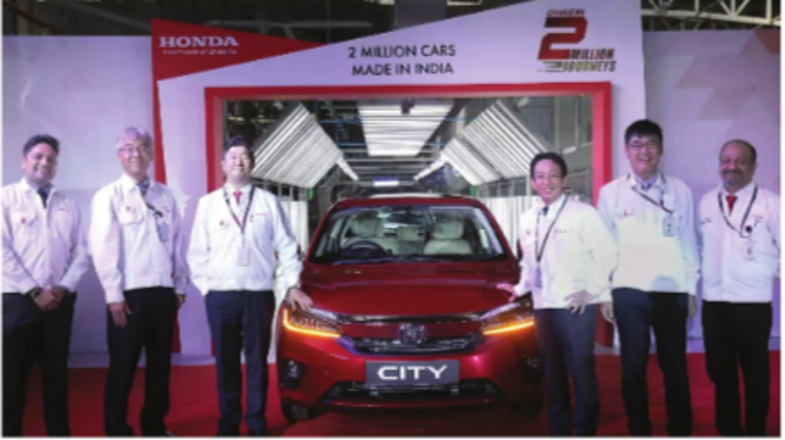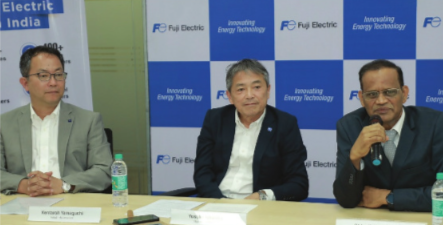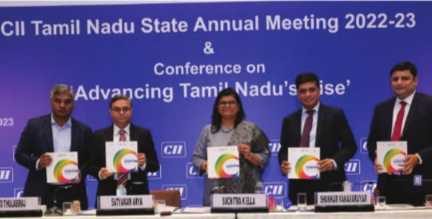A round up of important corporate events that happened across India.
Time to grow is now!
Anantha Nageswaran (AN), Chief Economic Advisor to the centre wears a crowded hat. He is a writer, author, teacher, consultant and now a professional speaker. Venugopal Kasturi, Director, Kasturi and Sons Ltd reminisced the first column written by AN in the Business Line. In 1998, he had written about disinvestment of Air India. 25 years later, it came true, just a day before AN joined the office; a prediction well ahead of his times, indeed.
At an event organised by the Chennai International Centre, AN addressed the students of Ethiraj College for women. He discussed in detail if global headwinds have delayed India’s march to a USD 5 trillion economy. Currently, developed countries are facing negative growth. He pointed to India having outgrown of that phase and entering a high growth period. As this coincides with investment cycle, he is sure that India would benefit much. Currently along with inflation, high interest rates are reeling in the west. While this has led to collapse of banks, on the other hand, it has led to rise in dollar value against the rupee. While this may harm exports, AN pointed to the increase in domestic demand to balance it: “as GDP rises, private consumption increases both at urban and rural centres.”
On the other hand, AN highlighted an important factor related to exports of IT software, “the industry is really recession proof. When western economies boom, the corporate’s front office offer work and when it reels under stress, the back office offers work. In both scenarios, the Indian IT software export benefits.” AN assures growth would be faster in the years to come and credits it to private sector participation, digitalisation and efficient resource allocation.
One new car every year – Honda Cars

The Tapukara plant in Rajasthan has an annual capacity of 180,000 which could be extended up to 200,000. “During April-February 2022-23, the company’s domestic volumes increased by around 8 per cent, selling over 90,000 vehicles. The company is expected to grow by around 30 per cent in the second half of FY24,” said Yuichi Murata, Director, Marketing and Sales. This would be in line with the launch of new vehicles coinciding with the festive season. The global company has set a strategy of moving completely to EV by 2040.
There has been a 25 per cent growth in exports too. Over 23,000 cars were sold to Turkey, Mexico, S.Africa and the company looks forward to expand to more countries. The new Honda City has been launched in two variants and it holds a strong market share of 37 per cent in Tamil Nadu and around 3 per cent all over India. Amaze garners a market share of 19 per cent all over India and 26 per cent in Tamil Nadu. The City variant is 95 per cent indigenised.
With 326 showrooms across India, 184 are in Tier III cities. Of these, 30 are in Tamil Nadu comprising 16 in Tier 2 and 3 towns. The company feels that it has enough coverage. The outlets are being revamped to be in line with the new corporate identity.
Fuji Electricals inaugurates new plant

The company plans to invest Rs 300-400 crore and is expected to reach revenue of Rs 1500 crore by FY 25. It has registered Rs 790 crore revenue this year and is expected to reach Rs 1000 crore in FY23 and around Rs 1250 crore in FY24. The company exports to SE Asia, the Middle East and Africa. However, exports are low at around 10 – 15 per cent. The company is expected to fetch around Rs 100 crore through exports by FY 25.
This fully automated facility will employ around 250 and the company is also looking to set up a R&D centre in Chennai. “We offer high levels of customisation and it helps us to garner a market share. We expect to grow over 25 per cent in coming years,” said Yosuke Ishizaka, Managing Director.
More investments needed to realise the trillion-dollar dream

Pooja Kulkarni, Special Secretary, Industries department, highlighted how the government is addressing this: “we are looking at a CAGR of 15 per cent and we believe it is achievable in the current scenario. As we progress into a developed economy, the government has realised that agricultural jobs will be displaced. To provide employment to the displaced workers, the government has planned to set up industries in non-leather goods, garments and renewable sectors in Tier 2 and 3 cities,” said Kulkarni. At the same time, the government is also looking to expand its IT services in the hinterland areas of the state by setting up TIDEL Parks in several districts.
Shankar Vanavarayar, Executive Director, ABT Industries Ltd, has been elected Chairman of CII Tamil Nadu State Council for 2023-24. He is the President of Kumaraguru Institutions. Srivats Ram, Managing Director, Wheels India Ltd, has been elected as Vice Chairman.
Rs 4 lakh crore investment in 4 years and over 50,000 new jobs

Dr D S Rawat, Chairman, MSME EPC credited this to the state’s initiative to attract domestic and foreign investors and a significant number of them were in the manufacturing industry. In 2021-22, the state received new investment proposals to the tune of Rs 85,831.49 crore and during the pandemic year 2020-21 it was worth Rs 85,556.98 crore.
In 2021-22, the government completed projects worth Rs 24,849.99 crore and revived projects for Rs 1647.10 crore. As per the data from Centre for Monitoring of Indian Economy (CMIE), the total investment projects outstanding were Rs 1,421,792.38 crore and under implementation were of Rs 754,634.33 crore.
The study attributed continuous flow of investments, both domestic and foreign, due to the state’s highly developed infrastructure, mature industrial ecosystem and logistics capabilities.
The study found that a number of micro and ancillary units are coming up even in rural areas. Reportedly, there are over 50 lakh MSMEs, next to Uttar Pradesh and West Bengal. In terms of types of ownership, proprietorship consists of 91.13 per cent, partnership 0.44 per cent, companies 0.10 per cent, self-help groups 0.26 per cent and others 6.11 per cent. It was observed that an overwhelming majority of MSMEs are self-financed and initial investments come from their own sources of funds or through informal sources.
To strengthen the MSME sector, the state has taken several initiatives including handholding and financial support. Looking at the state’s economy, the government happens to be a major investor with 52 per cent of total investments across various sectors, followed by Indian investors at 29.9 per cent and foreign private investors at 14.9 per cent.

A joint venture between Shriram Capital Ltd, the holding company of the Shriram Group and South Africa based Sanlam Ltd, Shriram Life, has set high goals to enter its second decade in true style. The approach is digital first and the company has already set forth on the journey. With its focus on serving the under-served, Shriram Life plans to augment customer experience through digitalisation. About 44 per cent of its customers are from rural background and the company’s average ticket size is around Rs 19,700 while the industry standard is Rs 75,000. By FY25, the company targets to improve on various fronts. Currently 80 per cent of the new customers, onboard using the Astha mobile app and the duration for the same has been reduced to 7 minutes from 24 – 48 hours earlier. By FY25, the company aims to become paperless and reduce onboarding time to 4 minutes. Currently close to 48 per cent of all payments are made through digital and the company is looking forward to increase it to 70 per cent.
Claims settlement is an important criteria for insurance. The current tunaround of 12 hours is expected to be reduced to 6 hours. At present around 91 per cent of non-investigated claims are settled and this is expected to increase to 98 per cent with lesser wait period.
“This has been possible through data analytics that helps us to understand the customer and assess the risk better,” said Casparus J K Kromhout, MD & CEO. The company is confident of making a profit of Rs 150 crore this year, against Rs 3 crore in FY22 and Rs 106 crore in FY21.
On launching the Smart Suraksha card, KRC Sekhar, Managing Director, said, “Our focus segment is very difficult to reach, large in size and untapped. We have learnt through the years and we will continue to serve this market.”
The smart card displays policy holder name, beneficiary name, their photographs and a QR code. The photos help to remind and motivate for whom the policy has been taken while the QR code has the policy details. If this will help in timely payment of premium, a study may perhaps reveal.

